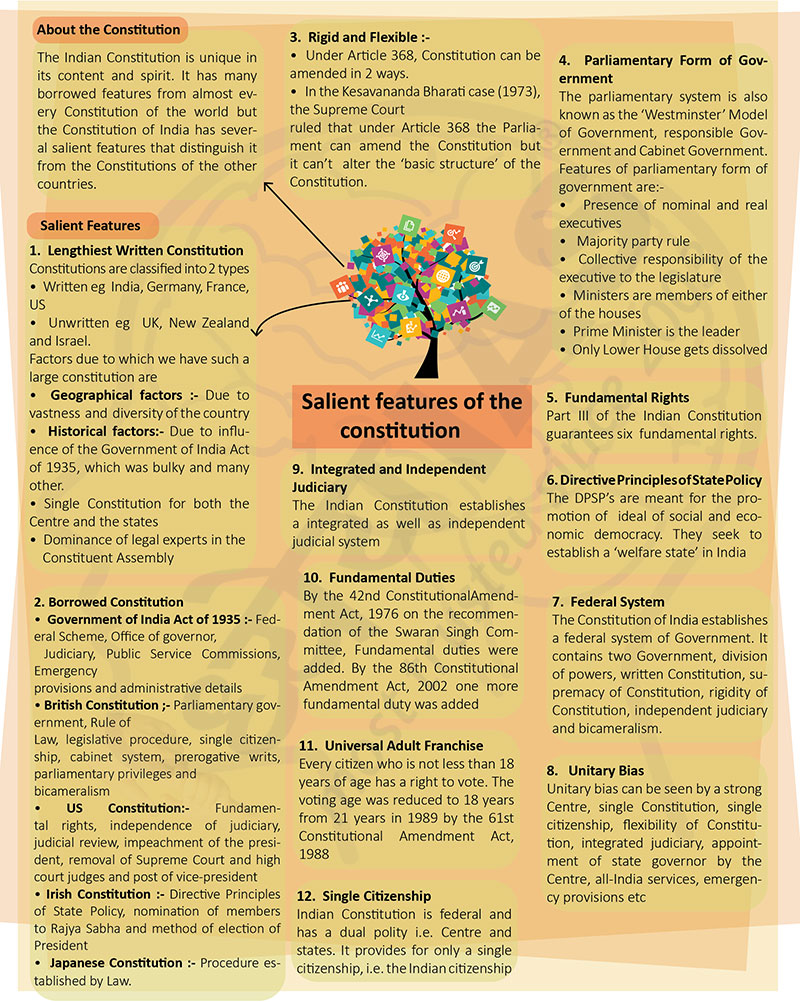About the Constitution
The Indian Constitution is unique in its content and spirit. It has many borrowed features from almost every Constitution of the world but the Constitution of India has several salient features that distinguish it from the Constitutions of the other countries.
Salient Features
1. Lengthiest Written Constitution
Constitutions are classified into 2 types
- Written eg India, Germany, France, US
- Unwritten eg UK, New Zealand and Israel.
Factors due to which we have such a large constitution are
- Geographical factors :- Due to vastness and diversity of the country
- Historical factors:- Due to influence of the Government of India Act of 1935, which was bulky and many other.
- Single Constitution for both the Centre and the states
- Dominance of legal experts in the Constituent Assembly
2. Borrowed Constitution
- Government of India Act of 1935 :- Federal Scheme, Office of governor, Judiciary, Public Service Commissions, Emergency provisions and administrative details
- British Constitution ;- Parliamentary government, Rule of Law, legislative procedure, single citizenship, cabinet system, prerogative writs, parliamentary privileges and bicameralism
- US Constitution:- Fundamental rights, independence of judiciary, judicial review, impeachment of the president, removal of Supreme Court and high court judges and post of vice-president
- Irish Constitution :- Directive Principles of State Policy, nomination of members to Rajya Sabha and method of election of President
- Japanese Constitution :- Procedure established by Law.
3. Rigid and Flexible :-
- Under Article 368, Constitution can be amended in 2 ways.
- In the Kesavananda Bharati case (1973), the Supreme Court ruled that under Article 368 the Parliament can amend the Constitution but it can’t alter the ‘basic structure’ of the Constitution.
4. Parliamentary Form of Government
The parliamentary system is also known as the ‘Westminster’ Model of Government, responsible Government and Cabinet Government.
Features of parliamentary form of government are:-
- Presence of nominal and real executives
- Majority party rule
- Collective responsibility of the executive to the legislature
- Ministers are members of either of the houses
- Prime Minister is the leader
- Only Lower House gets dissolved
5. Fundamental Rights
Part III of the Indian Constitution guarantees six fundamental rights.
6. Directive Principles of State Policy
The DPSP’s are meant for the promotion of ideal of social and economic democracy. They seek to establish a ‘welfare state’ in India
7. Federal System
The Constitution of India establishes a federal system of
Government. It contains two Government, division of powers, written
Constitution, supremacy of Constitution, rigidity of Constitution, independent
judiciary
and bicameralism.
8. Unitary Bias
Unitary bias can be seen by a strong Centre, single Constitution, single citizenship, flexibility of Constitution, integrated judiciary, appointment of state governor by the Centre, all-India services, emergency provisions etc.
9. Integrated and Independent Judiciary
The Indian Constitution establishes a integrated as well as independent judicial system
10. Fundamental Duties
By the 42nd Constitutional Amendment Act, 1976 on the recommendation of the Swaran Singh Committee, Fundamental duties were added. By the 86th Constitutional Amendment Act, 2002 one more fundamental duty was added
11. Universal Adult Franchise
Every citizen who is not less than 18 years of age has a right to vote. The voting age was reduced to 18 years from 21 years in 1989 by the 61st Constitutional Amendment Act, 1988
12. Single Citizenship
Indian Constitution is federal and has a dual polity i.e. Centre and states. It provides for only a single citizenship, i.e. the Indian citizenship.









